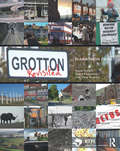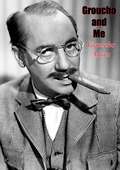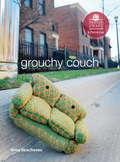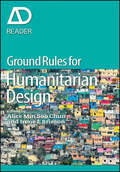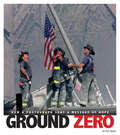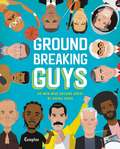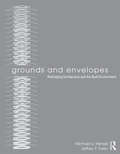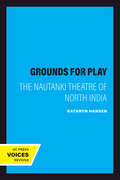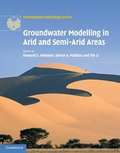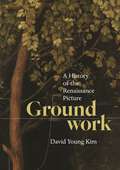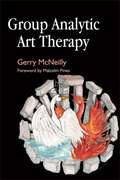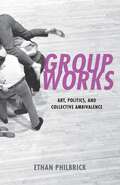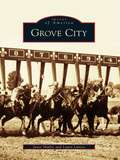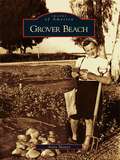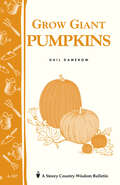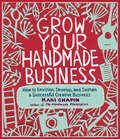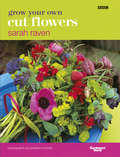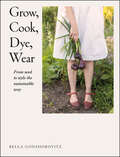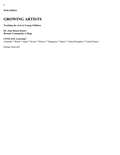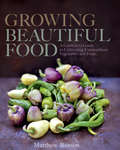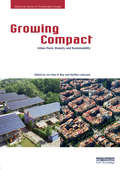- Table View
- List View
Grotton Revisited: Planning in Crisis? (RTPI Library Series)
by Steve Ankers David Kaiserman Chris ShepleySome thirty years ago the small Metropolitan County of Grotton found itself bathed in the bright glare of publicity as The Grotton Papers lifted the lid on the inner workings of the six planning departments of this hitherto little remarked corner of England. The intervening years have seen Grotton's County Council aim at the admirable and mostly achievable target of becoming "average with moderate prospects of remaining average" in the Government rankings, and the struggles of the District Councils to come to terms with planning in the late twentieth – let alone twenty-first – century are once again under the spotlight. The original authors of The Grotton Papers have come together once more to offer an experienced and surprisingly unjaundiced look at the way the British planning system works. Their comprehensive survey allows real lessons to be learnt from what Grotton has – and just as importantly hasn't – done since they were last in town. Grotton Revisited is without doubt the finest (and indeed the only) satirical book on this vitally important subject. It is suitable for planners of all ages and abilities, and will be essential reading for anyone who has ever had contact with the planning system, or thinks they may know someone who has. First class entertainment and education for professionals and general readers alike. Published in association with the RTPI.
Groucho Marx
by Lee SiegelBorn Julius Marx in 1890, the brilliant comic actor who would later be known as Groucho was the most verbal of the famed comedy team, the Marx Brothers, his broad slapstick portrayals elevated by ingenious wordplay and double entendre. In his spirited biography of this beloved American iconoclast, Lee Siegel views the life of Groucho through the lens of his work on stage, screen, and television. The author uncovers the roots of the performer's outrageous intellectual acuity and hilarious insolence toward convention and authority in Groucho's early upbringing and Marx family dynamics. The first critical biography of Groucho Marx to approach his work analytically, this fascinating study draws unique connections between Groucho's comedy and his life, concentrating primarily on the brothers' classic films as a means of understanding and appreciating Julius the man. Unlike previous uncritical and mostly reverential biographies, Siegel's "bio-commentary" makes a distinctive contribution to the field of Groucho studies by attempting to tell the story of his life in terms of his work, and vice versa. "
Groucho and Me: The Autobiography (Classics Of Modern American Humor Ser.)
by Groucho MarxThe “Me” in the title is a comparatively unknown Marx named Julius (1895-1977), who, under the nom de plume of Groucho, enjoyed a sensational career on Broadway and in Hollywood with such comedy classics as Animal Crackers, Monkey Business, Horse Feathers, Duck Soup, A Night at the Opera, and A Day at the Races. His solo career included work as a film actor, television game show emcee, and author of The Groucho Letters, Memoirs of a Mangy Lover, and his classic autobiography, Groucho and Me.With impeccable timing, outrageous humor, irreverent wit, and a superb sense of the ridiculous, Groucho tells the saga of the Marx Brothers: the poverty of their childhood in New York’s Upper East Side; the crooked world of small-time vaudeville (where they learned to carry blackjacks); how a pretzel magnate and the graceless dancer of his dreams led to the Marx Brothers’ first Broadway hit, I’ll Say She Is!, how the stock market crash in 1929 proved a godsend for Groucho (even though he lost nearly a quarter of a million dollars); the adventures of the Marx Brothers in Hollywood, the making of their hilarious films, and Groucho’s triumphant television series, You Bet Your Life!. Here is the life and lunatic times of the great eccentric genius, Groucho, a.k.a. Julius Henry Marx.“The book is never less than readable and its glimpses of American show business at its least glamorous are simple, true and sometimes rather touching.”—Times Literary Supplement“My advice is to ration yourself to a chapter a night—it’s that delectable.”—Chicago Sunday Tribune
Grouchy Couch: E-pattern from Knitting Mochimochi (Potter Craft ePatterns)
by Anna HrachovecKnitting instructions.
Ground Control: A Design History of Technical Lands and NASA’s Space Complex
by Jeffrey S. NesbitGround Control: A Design History of Technical Lands and NASA’s Space Complex explores the infrastructural history of the United States rocket launch complex. Working primarily between 1950, the year of the first rocket launch at Cape Canaveral, to 1969, the Apollo moon landing, the book highlights the evolution of its overlooked architecture and infrastructural landscape in parallel to US aerospace history. The cases outlined in this book survey the varying architectural histories and aesthetic motivations that helped produce America’s public image of early space exploration. The built environment of the U.S. space complex shows how its expanded infrastructural landscape tended to align with national Cold War politics and themes found in the age of modernity. Examples across often inaccessible sites of remote landscape help explain the contingent histories and deep association of an American aesthetic, land-use, and ultimately a form of nation-building practices. Ground Control offers a new way of understanding how technological uses of place-based science were designed and constructed in support of both industrial and military activities in postwar America. This book will be of interest to researchers, scholars, students, and anyone with a general interest in the history of American infrastructure, land use, and space exploration.
Ground Rules in Humanitarian Design
by Alice Min Soo Chun Irene E. BrissonDelve deep into the complex issues surrounding humanitarian design Ground Rules in Humanitarian Design establishes essential foundations for thinking about humanitarian design and its role in global change. Outlining a vital framework for designing for impoverished and disaster-stricken communities, this informative guide explores the integration of culture, art, architecture, economy, ecology, health, and education. Experts on land, health, water, housing, education, and planning weigh in with best practices and critical considerations during the design process, and discussion of the environmental considerations and local materials/skills will broaden your understanding of this nuanced specialty. Richly illustrated, this guide combines graphic documentation of projects, maps, and data-tracking developments from Asia, Africa, and the Americas to underscore the complexities of this emerging and evolving field. The ambition to provide humanitarian architecture for areas in acute need is driving design innovation worldwide among both practitioners and educators. This book provides an indispensable resource for those engaged in the search for the sustainable inclusion of cultural code and compassion as a technology for design innovation. Learn how to approach the problem of humanitarian design Understand the cultural factors that play into development Develop a new framework for planning post-disaster design See how humanitarian design is pushing the industry forward While still in college, students are being given the opportunity to directly participate in programmes that provide vital facilities for communities abroad. While these international initiatives remain largely ad hoc, this book provides parameters for engagement and establishes best practices for approaching these projects with a global perspective. With expert insight and practical strategies on the ground, Ground Rules in Humanitarian Design is an essential resource for architects at any level.
Ground Zero: How a Photograph Sent a Message of Hope (Captured History)
by Don NardoThe tragic events of September 11, 2001 sent shockwaves around the globe that are still felt today. Nearly 3,000 people died in the terrorist attacks and thousands more were injured. On the afternoon of the attacks, three firefighters paused in their rescue work to raise an American flag at Ground Zero in New York City. In the midst of horror and despair, the iconic photo of the men would remind Americans that they were far from beaten. It represented the country's strength, courage, decency, and its hope for the future.
Groundbreaking Guys: 40 Men Who Became Great by Doing Good
by Stephanie True Peters Shamel WashingtonAn illustrated book of biographies highlighting the inspiring and innovative qualities of forty very different men throughout history, for fans of Heroes for My Son and Good Night Stories for Rebel Girls.Our history books are full of great men, from inventors to explorers to presidents. But these great men were not always good men. It's time for our role models to change. This book pays tribute to Mr. Rogers, Barack Obama, Hayao Miyazaki, and more: men whose masculinity is grounded in compassion and care. These men have varying worldviews and are accomplished in a range of fields, but they share important commonalities. They served their communities. They treated people with respect. They lifted others up. And they went on to create change, inspire others, and, indeed, do great things--not in spite of their goodness, but because of it.These men's stories will educate, entertain, and encourage the next generation of writers, activists, entrepreneurs, and other leaders of all genders to do better and be better--to be truly groundbreaking.
Grounds and Envelopes: Reshaping Architecture and the Built Environment
by Michael U. Hensel Jeffrey P. TurkoProviding a source of vision for the revitalisation of ground and envelope as spatial elements that can inform the search for embedded locally specific architectures, this book collects essays and projects that each contributes a particular element to what might constitute an integrated and richly nuanced approach to spatial organisation. Projects include: Paulo Mendes da Rocha; Brazilian Pavilion, Osaka World Expo 1970, Osaka, Japan RCR Arquitectes: Marquee at Les Cols Restaurant, Olot, Girona, Spain Weiss / Manfredi; Seattle Art Museum: Olympic Sculpture Park, Seattle, Washington, USA Peter Eisenman; City of Culture of Galicia, Santiago de Compostela, Spain Plasma Studio and Groundlab; Xi’an Horticultural Expo, Longgang, China Foreign Office Architects; Yokohama International Ferry Terminal, Yokohama, Japan Nekton Design; Turf City, Reykjavik, Iceland Alvaro Siza; Swimming Pool, Leça da Palmeira, Portugal Eduardo Souto de Moura; Braga Municipal Stadium, Braga Portugal MVRDV; Villa VPRO, Hilversum, Netherlands Bernard Tschumi; Le Fresnoy Art Centre, Tourcoing, France OCEAN; World Centre for Human Concerns, New York City, USA R&Sie(n); Spidernethewood, Nîmes, France Toyo Ito; Serpentine Pavilion, London, England Enric Miralles and Carme Pinós; Olympic Archery Range, Barcelona, Spain Kengo Kuma; GC Prostho Museum Research Centre, Aichi Prefecture, Japan Cloud 9; MediaTic, Barcelona, Spain Diller, Scofidio and Renfro; Blur Building, Yverdon-les-Bains, Switzerland, Swiss National Expo With an abundance of built and un-built key projects available, it is now possible to outline the contours of a new discourse. This book initiates a new beginning in this direction so that architecture can partake in the creation of heterogeneous space and culturally, socially and environmentally sustainable built environments.
Grounds for Play: The Nautanki Theatre of North India
by Kathryn HansenThe nautanki performances of northern India entertain their audiences with often ribald and profane stories. Rooted in the peasant society of pre-modern India, this theater vibrates with lively dancing, pulsating drumbeats, and full-throated singing. In Grounds for Play, Kathryn Hansen draws on field research to describe the different elements of nautanki performance: music, dance, poetry, popular story lines, and written texts. She traces the social history of the form and explores the play of meanings within nautanki narratives, focusing on the ways important social issues such as political authority, community identity, and gender differences are represented in these narratives.Unlike other styles of Indian theater, the nautanki does not draw on the pan-Indian religious epics such as the Ramayana or the Mahabharata for its subjects. Indeed, their storylines tend to center on the vicissitudes of stranded heroines in the throes of melodramatic romance. Whereas nautanki performers were once much in demand, live performances now are rare and nautanki increasingly reaches its audiences through electronic media—records, cassettes, films, television. In spite of this change, the theater form still functions as an effective conduit in the cultural flow that connects urban centers and the hinterland in an ongoing process of exchange.
Groundwater Modelling in Arid and Semi-Arid Areas
by Howard S. Wheater Simon A. Mathias Xin LiArid and semi-arid regions face major challenges in the management of scarce freshwater resources under pressures of population, economic development, climate change, pollution and over-abstraction. Groundwater is commonly the most important water resource in these areas. Groundwater models are widely used globally to understand groundwater systems and to guide decisions on management. However, the hydrology of arid and semi-arid areas is very different from that of humid regions, and there is little guidance on the special challenges of groundwater modelling for these areas. This book brings together the experience of internationally-leading experts to fill a gap in the scientific and technical literature. It introduces state-of-the-art methods for modelling groundwater resources, illustrated with a wide-ranging set of illustrative examples from around the world. The book is valuable for researchers, practitioners in developed and developing countries, and graduate students in hydrology, hydrogeology, water resources management, environmental engineering and geography.
Groundwork: A History of the Renaissance Picture
by David Young KimAn illuminating look at a fundamental yet understudied aspect of Italian Renaissance paintingThe Italian Renaissance picture is renowned for its depiction of the human figure, from the dramatic foreshortening of the body to create depth to the subtle blending of tones and colors to achieve greater naturalism. Yet these techniques rely on a powerful compositional element that often goes overlooked. Groundwork provides the first in-depth examination of the complex relationship between figure and ground in Renaissance painting.“Ground” can refer to the preparation of a work’s surface, the fictive floor or plane, or the background on which figuration occurs. In laying the material foundation, artists perform groundwork, opening the ground as a zone that can precede, penetrate, or fracture the figure. David Young Kim looks at the work of Gentile da Fabriano, Giovanni Bellini, Giovanni Battista Moroni, and Caravaggio, reconstructing each painter’s methods to demonstrate the intricacies involved in laying ground layers whose translucency and polychromy permeate the surface. He charts significant transitions from gold ground painting in the Trecento to the darkened grounds in Baroque tenebrism, and offers close readings of period texts to shed new light on the significance of ground forms such as rock face, wall, and cave.This beautifully illustrated book reconceives the Renaissance picture, revealing the passion and mystery of groundwork and discovering figuration beyond the human figure.
Group Analytic Art Therapy
by Gerry McneillyGroup Analytic Art Therapy, written by an internationally renowned psychotherapist, provides readers with a practical and theoretical framework for using group art therapy in a range of settings. Based on over 20 years' experience of conducting group art therapy, this book is packed with suggestions for group art therapy practice and many explanatory diagrams. The author also explores the dynamics and psychological effects of diverse group situations, based on examples from his own clinical practice, and offers an illuminating insight in to his own theories and practical applications of group art therapy in the context of the developments in the field. Group Analytic Art Therapy is both a comprehensive reference and an inspiring text for practising and trainee art therapists, psychotherapists and group therapists.
Group Works: Art, Politics, and Collective Ambivalence
by Ethan PhilbrickAn exciting new reflection on the role of artistic collaboration, collectivism, and the politics of group formation in the neoliberal era.The artist and author Ethan Philbrick’s Group Works re-imagines the group by undertaking an historiographic archaeology of group aesthetics and politics.Written against both phobic and romantic accounts of collectivity, Group Works contends that the group emerges as a medium for artists when established forms of collective life break down. Philbrick pairs group pieces in dance, literature, film, and music from the 1960s and 1970s downtown Manhattan scene alongside a series of recent group experiments: Simone Forti’s dance construction, Huddle (1961), is put into relation with contemporary re-performances of Forti’s score and huddling as a feminist political tactic; Samuel Delany’s memoir of communal living, Heavenly Breakfast: An Essay on the Winter of Love (1969/78), speaks to performance artist Morgan Bassichis’s 2017 communal musical adaptation of Larry Mitchell’s 1977 text, The Faggots and Their Friends Between Revolutions; Lizzie Borden’s experimental documentary of feminist collectivity, Regrouping (1976), sits alongside visual artist Sharon Hayes’s 2014 piece on Manhattan’s Pier 54, Women of the World Unite! they said; and Julius Eastman’s insurgent piece of chamber music for four pianos, Gay Guerrilla (1979), resonates alongside contemporary projects that take up Eastman’s legacy by artists such as Tiona Nekkia McClodden.By analyzing works that articulate the politics of race, gender, and sexuality as questions of group formation, Philbrick approaches the group not as a stable, idealizable entity but as an ambivalent way to negotiate and contest shifting terms of associational life. Group Works presents an engaging exploration of what happens when small groups become a material and medium for artistic and political experimentation.
Grove City
by Laura Lanese Janet ShailerAs part of the Northwest Territory, the land encompassing Grove City served as payment to war heroes Gen. Daniel Morgan and Col. William Washington, a distant relative of George Washington, for their Revolutionary War service. They in turn sold this land, and in 1803, the region's first pioneers, Hugh Grant and his wife, Catherine Barr, settled close to what is now downtown Grove City. In 1852, Grove City founder William F. Breck laid out the town plat and helped incorporate the village in 1856. Grove City remained a small farming village throughout the 19th and much of the 20th century, despite its proximity to the fast-growing capital city of Columbus. While the beginning of the 21st century has brought dramatic growth, Grove City continues to hold on to its vibrant, small-town character through its Roaring Twenties-era Thoroughbred racetrack, its picturesque town center, and the numerous educational activities hosted by the Southwest Franklin County Historical Society.
Grove City
by Laura Lanese Janet Shailer Kelli Milligan StammenCarved out of Ohio's wilderness in 1852, the village of Grove City welcomed industrious laborers, farmers, and German immigrants. The arrival of the railroad and the interurban brought commuters willing to travel from Grove City into Columbus. The 1960s saw the construction of Interstates 71 and 270, which spurred the community's growth. Though its population has surpassed 37,000 residents, Grove City has retained its small-town appeal while offering residents and visitors a revitalized town center, a major arts festival, and the "world's largest" alumni softball tournament.
Groveport and Madison Township, Ohio
by Richard Lee PalsgroveEsau Decker walked to southeastern Franklin County from the Shenandoah Valley in 1805. Marking his Ohio property with a walking stick, Decker returned with his Virginia family the following year to discover that the willow cane had taken root and was growing. It is from this same fertile soil that farms, businesses and social groups grew to create the village of Groveport and the thriving farming community with which it is forever intertwined, Madison Township.Groveport and Madison Township, Ohio contains nearly two hundred vintage photographs that illustrate how the area grew from a nineteenth-century wilderness outpost to become the vibrant and successful place it is today. Featured here are the canal and railroad days that established the area as a local hub of transportation, the formation of the churches and school system that bind the village and township together, the region's spectacular architecture and some of the more notable people of the community, such as world-renowned horse trainer John S. Rarey of Groveport, who earned international fame as an original "horse whisperer."
Grover Beach
by Anita ShowerThe city of Grover Beach is nestled in the dunes of the California coastline in San Luis Obispo County. In 1842, Jose Ortego received a Mexican land grant and made the first claim on the area. Ortego sold his 8,838 acres to Isaac Sparks in 1867, and Sparks later sold half to John Price. Price sold his share to Dwight William Grover for $22,982.20 in gold. By 1887, Grover had filed with the county and founded the Town of Grover. Developers John F. Beckett in 1892 and Horace V. Bagwell in 1935 followed. Growing gradually, the city incorporated in 1959, changed its name to Grover Beach in 1992, and received Amtrak rail service in 1996--a permanent connection to the surrounding communities and commerce. The city has come full circle, from D. W. Grover's dream to reality.
Grow Giant Pumpkins: Storey's Country Wisdom Bulletin A-187 (A\storey Country Wisdom Bulletin Ser. #Vol. 187)
by Gail DamerowSince 1973, Storey's Country Wisdom Bulletins have offered practical, hands-on instructions designed to help readers master dozens of country living skills quickly and easily. There are now more than 170 titles in this series, and their remarkable popularity reflects the common desire of country and city dwellers alike to cultivate personal independence in everyday life.
Grow Your Handmade Business: How to Envision, Develop, and Sustain a Successful Creative Business
by Kari ChapinAre you ready to make a living from your craft? Learn how to map out a financial plan, expand production, automate distribution, address legal matters, and much more. Start growing your business beyond the dining room table and leave your day job behind.
Grow Your Own Cut Flowers: a practical, step-by-step guide to growing the best flowers to pick and arrange at home
by Sarah RavenIf you're fed up with buying flowers to display and arrange at home, then look now further than this easy-to-follow, practical guide to growing your own cut flowers from gardening expert Sarah Raven (Gardener's World, The Daily Telegraph). With over 250 specially commissioned photos, top tips and step-by-step instructions, this book is the first step to having a house full of sophisticated and stylish home-grown arrangements!'She makes it so simple. Once Sarah has had her way with you, you will never need to buy another bunch of out-of-season Kenyan roses again.' -- The Guardian'Absolutely fantastic!' -- ***** Reader review'A must for all flower lovers' -- ***** Reader review'Inspirational' -- ***** Reader review'Sarah Raven is the best!' -- ***** Reader review'Beautifully illustrated and full of imaginative ideas' -- ***** Reader review*******************************************************************************************************Demystifying the world of floristry, Grow Your Own Cut Flowers by Sarah Raven (Gardener's World, The Daily Telegraph) is perfect for beginner gardeners, flower arrangers wanting to grow their own flowers and experienced gardeners wanting ideas to fill a house with their harvest. With insider tips on sowing seed, conditioning flowers and putting together stylish arrangements for any occasion, step-by-step instructions, flower directories and over 250 specially commissioned photographs, this is an invaluable, practical and accessible guide to bringing a little bit of the outside into your house in a rewarding, stylish and sustainable way.
Grow, Cook, Dye, Wear: From Seed To Style The Sustainable Way
by Bella GonshorovitzA fully illustrated, practical guide that explains how to follow a sustainable approach to food and fashionLive sustainably with style – grow fruits and vegetables, cook them, create natural dyes, then make your own clothes with five full-size pattern sheets.Swap food waste and fast fashion for homegrown produce, delicious vegan dishes, and a contemporary capsule wardrobe with the help of fashion designer, dressmaker, and writer Bella Gonshorovitz. Focused around five crops (blackberry, nettle, onion, red cabbage and rhubarb) that can be foraged or grown in an allotment, planter, or container, Bella shows you how to embrace a holistic garden-to-garment lifestyle. Learn how to forage, sow and harvest with straightforward grow guides.Enjoy your produce with advice on the best vegan pantry ingredients and recipes for vibrant, flavour-packed dishes.Create natural dyes from your food waste to upcycle fabrics in beautiful seasonal shades.Transform your fabrics into five exclusively designed, essential pieces, including a shirt dress and duster coat. From sowing to sewing, Bella guides you with engaging stories, easy-to-follow instructions, step-by-step illustrations, and full-scale pattern sheets. Whether you&’re looking to rethink your lifestyle, embrace slow fashion, try a plant-based diet or simply give grow your own a go, Bella&’s friendly, accessible approach to sustainable living will help you get started, create more and waste less.
Growing Artists: Teaching The Arts To Young Children
by Joan Bouza KosterGROWING ARTISTS: TEACHING THE ARTS TO YOUNG CHILDREN, 6th Edition, provides early childhood educators with the theoretical framework and background knowledge needed to design creative arts activities for young children from infancy through the primary grades. Beautifully illustrated with children's artwork, it features a wealth of child-tested, open-ended dramatic arts, music, creative dance, and visual art activities that foster children's creativity. Examples of teaching in action model how to be an enthusiastic and effective teacher of the arts process. This book provides a rich-resource of ideas and approaches that will inspire all those who work with young children to explore the arts process with them.
Growing Beautiful Food: A Gardener's Guide to Cultivating Extraordinary Vegetables and Fruit
by Matthew BensonWith the paradigm shift toward local and homegrown food, gardeners and foodies have come to relish beautiful vegetable gardens and beautiful meals. Author Matthew Benson writes that beauty inspires behavior, and he believes that we can and will eat better, be healthier, and live more sustainably when we grow food that's visually enticing.Benson restored a time-worn gentleman's farm and operates a CSA on one small acre of the land, offering vegetables, orchard fruit, cut flowers, herbs, eggs, and honey from the property. His garden-to-table operation offers an edible feast of textures, colors, and aromas and has grown into a way to feed others, while pushing back against the industrial food system in a small but meaningful way.Growing Beautiful Food is both inspiration and instruction, with detailed growing advice for 50 remarkable crops, a memorable narrative, and evocative imagery. It's a photographic journey through four seasons in the garden, fueling the dream that you can connect to the land by growing your own food. Benson encourages us to start small like he did, celebrate every harvest, and understand that heartbreaking crop losses are simply part of the process. Whether gardeners, families, farmers, or chefs, readers will come to the table motivated by the flavor of homegrown, the message of self sufficiency, and the beautiful food that's as local as their backyards.
Growing Compact: Urban Form, Density and Sustainability
by Steffen Lehmann Joo Hwa BayGrowing Compact: Urban Form, Density and Sustainability explores and unravels the phenomena, links and benefits between density, compactness and the sustainability of cities. It looks at the socio-climatic implications of density and takes a more holistic approach to sustainable urbanism by understanding the correlations between the social, economic and environmental dimensions of the city, and the challenges and opportunities with density. The book presents contributions from internationally well-known scholars, thinkers and practitioners whose theoretical and practical works address city planning, urban and architectural design for density and sustainability at various levels, including challenges in building resilience against climate change and natural disasters, capacity and integration for growth and adaptability, ageing, community and security, vegetation, food production, compact resource systems and regeneration.
